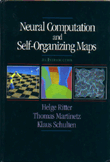Neural Computation

|
Neural Computation and Self-Organizing Maps - An Introduction
by Helge Ritter, Thomas Martinetz, and Klaus Schulten
About the Book:
This book is a comprehensive introduction to neural networks and neural information processing. It describes the most important models of neural networks and how they contribute to our understanding of information and organization processes in the brain. One of the few generally recognized organizational principles of the nervous system, the development of cortical feature maps (brain maps), is described in detail, and the reader is introduced to the biological background and the mathematical properties of self-organizing maps as important functional building blocks of the brain. Examples show how neural networks can solve important information processing tasks, including the development of sensory maps, the traveling salesman problem, and visuomotor control of robots.
About the Cover:
The images portray (from left to right): (I) a robot arm, learning movement control by using self-organizing maps: (ii) a model of mapping from the hand onto the somatosensory cortex of the brain: (iii) a theoretical study of phase transitions in topology-conserving maps.
|



